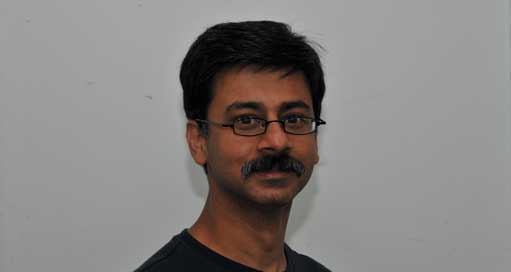
ATLAS e-News
23 February 2011
16 June 2008
Srini Rajagopalan
Nationality: US Citizen, Indian

Srini Rajagopalan
Forty million beam crossings, each containing about twenty collisions, must be processed and analysed each second with only two hundred of those selected and saved for further analysis. There are no second chances! That is the challenge of the ATLAS trigger system: forefront in the analysis of new discoveries at the LHC. Srini Rajagopalan, a physicist from Brookhaven National Laboratory (BNL) in New York, has taken up this challenge and is one of the scientists responsible for making sure that the trigger selects events that are rich in physics.
Born in India, Srini majored in physics in Bombay. While still an undergraduate, exciting news came from CERN about the discovery of the W and Z bosons: “I followed these developments with keen interest and there was no looking back”, he recalls about his preparations to embark on a career in particle physics.
Srini was a graduate student at Northwestern University near Chicago when he had his first opportunity to do experiments in the field of his passion. He took up an advanced particle physics lab course in his very first semester under the direction of a Swiss professor Bruno Gobbi: “I would stay late nights in the lab,” remembers Srini. His final lab exam was a dinner outing with Bruno and the rest is history; he soon found himself at Fermilab working on D0. There, once while on a night-owl shift and fuelled by caffeine, Srini slipped and twisted his leg as he rushed to tell his colleagues about what looked like a top quark event – such was the excitement in the days leading to its discovery.
Asked about the experience of moving from Bombay to Chicago, good memories come to Srini’s mind: “I was able to adapt to my new life easily. The hardest part was probably American football, wondering why overweight men enjoyed falling on each other,” he remembers about the first time he watched Chicago win their first superbowl. That did not stop him from taking up American citizenship later on though.
After earning his PhD from Northwestern and a post-doc at Stony Brook in New York, Srini joined BNL staff and started working on ATLAS. Before switching allegiance to the trigger, Srini spent over ten years working in the Liquid Argon group, coordinating software and performance tasks amongst other things: “You can spend decades in one experiment these days, so it is healthy to get involved in other aspects of the project,” says Srini, describing his transition to the trigger effort. At the moment, he travels between New York and CERN almost every other week. Asked how he puts up with his hectic travel and avoid getting stressed out, he replies: “Well, a long run and a cold beer chills me out.”
He enthusiastically encourages young people to join high energy physics: “Thanks to the LHC, there has been a spur of new post-doc and faculty jobs in recent years and it is also a ripe time for students to join as they will be able to perform analysis on real data,” he says. But, in the same breath, he expresses concern about the overall funding situation for science research in the US: “These are difficult times, but it is important that the US continues to recognize the value of funding basic scientific research and play a leading role at the international level,” he adds.
Srini feels very privileged to be part of this great scientific endeavour at CERN. After 12 years in ATLAS, he is eagerly awaiting for the LHC turn on. “I hope we find what we are looking for,” he says. “But it would be equally interesting if we do not find what we expect, but that’s quite unlikely.” Nevertheless, Srini is very optimistic: “We are about to turn the page and boldly go where no one has gone before. Resistance is futile!”